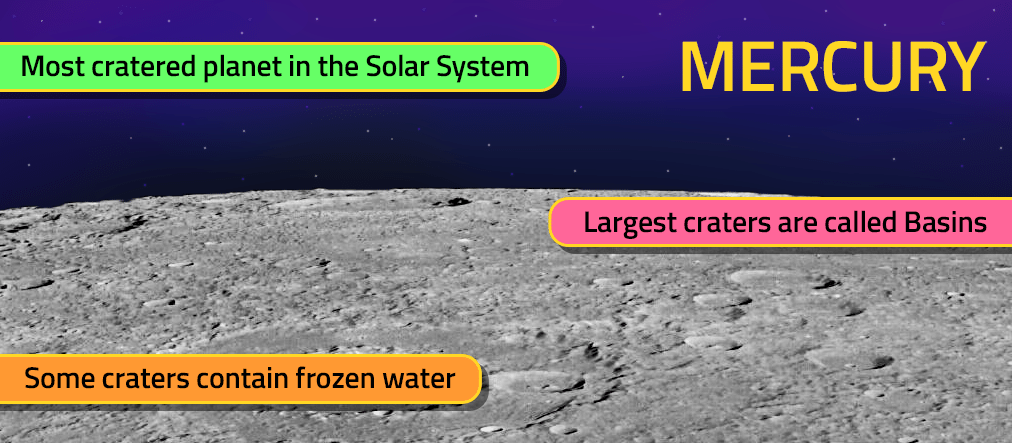Mercury's Craters
Before 1974, nobody really knew what Mercury looked like. It was known to be small and shaped like a ball (hey, that rhymes!), but that’s about it. Things changed though when Mariner 10 became the first space craft to visit Mercury in 1974. It flew past the planet three times, taking as many photographs as it possibly could each time it went by. You’ll never guess what those photos revealed. Okay, you probably will if you’ve looked at the title of this page. It revealed craters. Lots and lots of craters. If you get excited about craters, you’d love Mercury. If you don’t, well, there’s always Mars. Hang on, that has craters too. What about Jupiter? Yes, you’ll like Jupiter. It’s just gas. Anyway, Jupiter can wait. We’re here to talk about Mercury’s craters. Prepare to be astounded!

What are Craters and why are they there?
Craters are dents made on a planet’s surface from the impact of rocks as they smash into them. During the formation of the solar system, hundreds of thousands of rocks collided into each other over a period of millions of years. Larger rocks clumped together and became larger and larger until they eventually formed the planets that we know and love today. Even after the planets had formed, there were, and still are, rocks flying around the solar system and colliding with the planets.
Mercury has the most craters of all of the planets in the solar system. This is for three reasons:
Mercury is close to the Sun. As the Sun is gigantically huge, it has a strong pull of gravity which attracts nearby debris. Sometimes though, some of this debris hits poor old Mercury instead, leaving an impact on its surface.
Mercury doesn’t have an atmosphere. An atmosphere is a layer of gas that surrounds a planet. The other inner planets (Venus, Earth and Mars) all have an atmosphere which protects their surfaces. If rocks head for Earth, they usually burn up in its atmosphere. When this happens, they are quite often referred to as shooting stars because they glow as they fly through the sky. Mars’ atmosphere is very thin which is why it also has craters.
Mercury has no weather. Weather events like wind and rain help to redesign a planet’ surface appearance. Wind erodes surface details while rain washes them away. Mercury has none of this.
Although the solar system's planets and larger moons formed about 4.6 billion years ago as a result of collisions of rocks which eventually amassed and became the ball-shaped worlds that we know today, it is thought that most of the craters still visible on objects like Mercury, Mars and the Moon aren't as old as the worlds themselves. About 4.1 to 3.8 billion years ago, the inner planets came under an unusually heavy bombardment of asteroids and rocks. As it was around 600 million years after the objects formed, it is referred to as the Late Heavy Bombardment. It's not known what caused it although most guesses suggest there may have been a disturbance of asteroids in the asteroid belt which sent many of them into the inner solar system.

Some of Mercury’s craters are so large that they aren’t even called craters. Instead they are called basins.
These are craters that have a width of more than 400 kilometres (250 miles).
The largest basin on Mercury is
the Caloris Planitia basin. It has a diameter of about 1,525 kilometres (948 miles) and is thought to have been created
by an object over 100 kilometres (62 miles) wide crashing into the planet around 3.8 billion years ago. The
impact was so great that it caused visible ripple and shock waves on the planet. Smashing.
As the floor of the Caloris Planitia basin is quite smooth, it suggests that it was created after the heavy bombardment phase.
This makes it one of Mercury's youngest basins.
Many of the largest craters on Mercury are given names. This helps scientists to know what they looking at
and to find their way around the planet. They don’t just pick random names for craters though, like Keith, John, Barbara,
Britney. No, craters on Mercury are named after famous people from the arts world – poets, musicians, actors, writers and
so on. The only rule is that they must have been famous for over fifty years and have died more than three years before
the naming of the crater.
There’s a Disney crater on Mercury, named after Walt Disney. There’s also a Lennon crater, named after John Lennon, a famous
singer and songwriter in The Beatles. I suppose that means there actually is a crater called John then!
The actress who played the Good Witch in the film The Wizard of Oz (Billie Burke) has her very own crater on Mercury, as
well as PL Travers who created Mary Poppins. Other famous people with craters named after them include classical composers
Bach, Beethoven and Strauss, writers like Ernest Hemingway Charles Dickens, William Shakespeare and JRR Tolkein (writer of The Hobbit
and Lord of the Rings) and artists like Vincent Van Gogh, Rembrandt and Renoir.

Hidden inside some of Mercury’s craters is frozen water. Water is probably the last
thing you’d expect to find on a planet so close to the Sun. Mercury’s surface can be as hot as 427 °c (801 °F)
when it is facing the Sun. However the floors of some craters are in permanent shade from the Sun.
These craters
are located around Mercury’s north and south poles and are deep and have high rims. This means that any ice in
them never melts because heat from the Sun can never reach the dark depths of them. How the water got there is
another matter, with the most likely reason being that it was carried by a comet or other space rock that crashed into Mercury.





